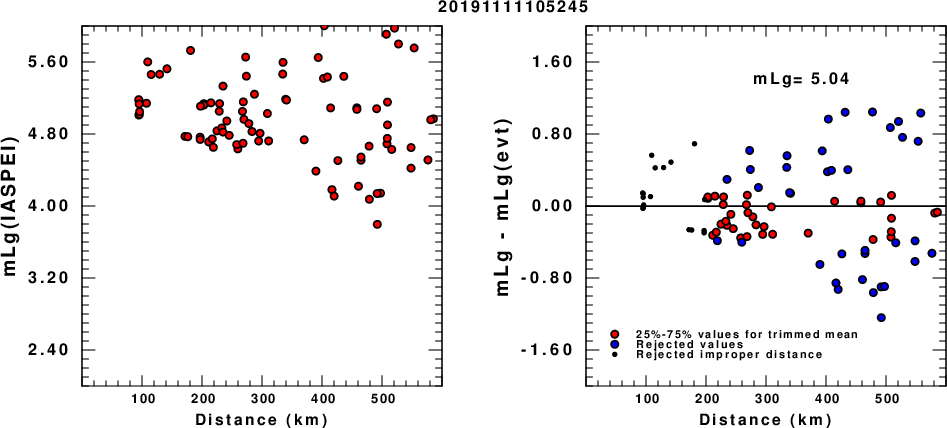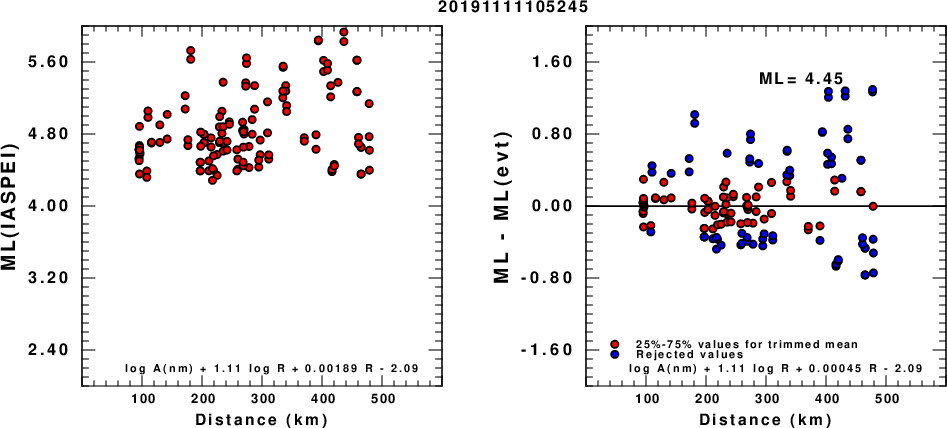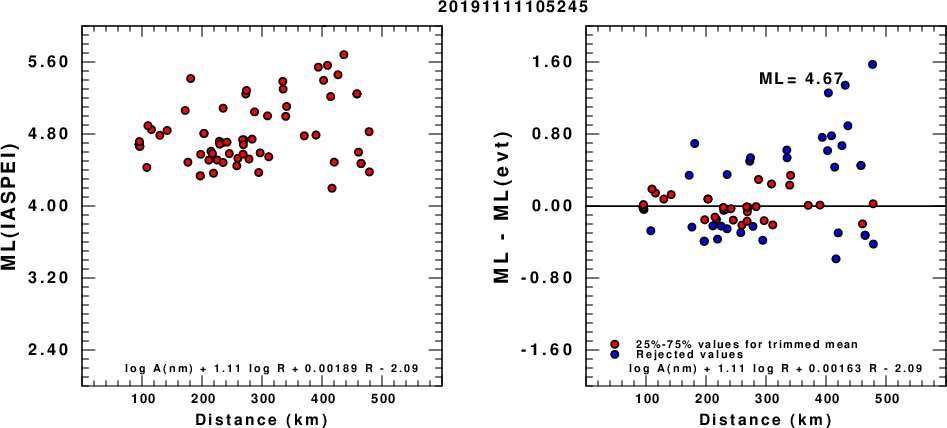Location
Location ANSS
2019/11/11 10:52:45 44.54 4.63 10.0 4.9 France
Focal Mechanism
USGS/SLU Moment Tensor Solution
ENS 2019/11/11 10:52:45:0 44.54 4.63 10.0 4.9 France
Stations used:
FR.ARBF FR.ARTF FR.ATE FR.BSTF FR.CALF FR.CARF FR.CFF
FR.CHMF FR.EILF FR.ESCA FR.FILF FR.FNEB FR.HOHE FR.ILLF
FR.ISO FR.LABF FR.LRVF FR.MLS FR.MLYF FR.MONQ FR.PAND
FR.PYLO FR.RUSF FR.SALF FR.SAOF FR.SPIF FR.TURF FR.URDF
FR.VIEF FR.WLS FR.ZELS GE.STU GE.WLF GU.BHB GU.ENR GU.GBOS
GU.GORR GU.PCP GU.POPM GU.PZZ GU.RORO GU.RRL GU.RSP GU.SATI
GU.STV IV.BDI IV.IMI IV.MONC IV.MSSA IV.PLMA IV.QLNO MN.BNI
MN.TUE MN.VLC RD.LOR RD.MTLF RD.ORIF
Filtering commands used:
cut o DIST/3.3 -30 o DIST/3.3 +60
rtr
taper w 0.1
hp c 0.02 n 3
lp c 0.06 n 3
Best Fitting Double Couple
Mo = 2.37e+23 dyne-cm
Mw = 4.85
Z = 22 km
Plane Strike Dip Rake
NP1 65 59 106
NP2 215 35 65
Principal Axes:
Axis Value Plunge Azimuth
T 2.37e+23 71 13
N 0.00e+00 14 236
P -2.37e+23 12 143
Moment Tensor: (dyne-cm)
Component Value
Mxx -1.20e+23
Mxy 1.15e+23
Mxz 1.09e+23
Myy -8.15e+22
Myz -1.31e+22
Mzz 2.02e+23
--------------
----------------####--
------------################
----------####################
----------########################
---------###########################
--------##############################
--------############ ###############--
-------############# T ##############---
-------############## #############-----
-------############################-------
------############################--------
------#########################-----------
-----#######################------------
-----####################---------------
----################------------------
############------------------------
###------------------------ ----
#------------------------ P --
#----------------------- -
----------------------
--------------
Global CMT Convention Moment Tensor:
R T P
2.02e+23 1.09e+23 1.31e+22
1.09e+23 -1.20e+23 -1.15e+23
1.31e+22 -1.15e+23 -8.15e+22
Details of the solution is found at
http://www.eas.slu.edu/eqc/eqc_mt/MECH.NA/20191111105245/index.html
|
Preferred Solution
The preferred solution from an analysis of the surface-wave spectral amplitude radiation pattern, waveform inversion and first motion observations is
STK = 215
DIP = 35
RAKE = 65
MW = 4.85
HS = 22.0
The NDK file is 20191111105245.ndk
Depth control was not good originally. However the moment tensor solution agrees with first motions. The depth for the RMT depends on the velocity model. This was not easy.
Moment Tensor Comparison
The following compares this source inversion to others
| SLU |
SLUFM |
GFZ |
OCA |
USGS/SLU Moment Tensor Solution
ENS 2019/11/11 10:52:45:0 44.54 4.63 10.0 4.9 France
Stations used:
FR.ARBF FR.ARTF FR.ATE FR.BSTF FR.CALF FR.CARF FR.CFF
FR.CHMF FR.EILF FR.ESCA FR.FILF FR.FNEB FR.HOHE FR.ILLF
FR.ISO FR.LABF FR.LRVF FR.MLS FR.MLYF FR.MONQ FR.PAND
FR.PYLO FR.RUSF FR.SALF FR.SAOF FR.SPIF FR.TURF FR.URDF
FR.VIEF FR.WLS FR.ZELS GE.STU GE.WLF GU.BHB GU.ENR GU.GBOS
GU.GORR GU.PCP GU.POPM GU.PZZ GU.RORO GU.RRL GU.RSP GU.SATI
GU.STV IV.BDI IV.IMI IV.MONC IV.MSSA IV.PLMA IV.QLNO MN.BNI
MN.TUE MN.VLC RD.LOR RD.MTLF RD.ORIF
Filtering commands used:
cut o DIST/3.3 -30 o DIST/3.3 +60
rtr
taper w 0.1
hp c 0.02 n 3
lp c 0.06 n 3
Best Fitting Double Couple
Mo = 2.37e+23 dyne-cm
Mw = 4.85
Z = 22 km
Plane Strike Dip Rake
NP1 65 59 106
NP2 215 35 65
Principal Axes:
Axis Value Plunge Azimuth
T 2.37e+23 71 13
N 0.00e+00 14 236
P -2.37e+23 12 143
Moment Tensor: (dyne-cm)
Component Value
Mxx -1.20e+23
Mxy 1.15e+23
Mxz 1.09e+23
Myy -8.15e+22
Myz -1.31e+22
Mzz 2.02e+23
--------------
----------------####--
------------################
----------####################
----------########################
---------###########################
--------##############################
--------############ ###############--
-------############# T ##############---
-------############## #############-----
-------############################-------
------############################--------
------#########################-----------
-----#######################------------
-----####################---------------
----################------------------
############------------------------
###------------------------ ----
#------------------------ P --
#----------------------- -
----------------------
--------------
Global CMT Convention Moment Tensor:
R T P
2.02e+23 1.09e+23 1.31e+22
1.09e+23 -1.20e+23 -1.15e+23
1.31e+22 -1.15e+23 -8.15e+22
Details of the solution is found at
http://www.eas.slu.edu/eqc/eqc_mt/MECH.NA/20191111105245/index.html
|

First motions and takeoff angles from an elocate run.
|
GFZ Event gfz2019wcnm
19/11/11 10:52:45.50
France
Epicenter: 44.59 4.65
MW 4.9
GFZ MOMENT TENSOR SOLUTION
Depth 13 No. of sta: 20
Moment Tensor; Scale 10**16 Nm
Mrr= 2.67 Mtt=-0.94
Mpp=-1.73 Mrt=-0.05
Mrp= 0.43 Mtp=-0.87
Principal axes:
T Val= 2.72 Plg=84 Azm=249
N -0.40 5 32
P -2.32 4 122
Best Double Couple:Mo=2.5*10**16
NP1:Strike=218 Dip=41 Slip= 98
NP2: 27 49 83
-----------
----------------#
-------------#######---
-----------##########----
----------##############-----
--------################-----
--------#################------
--------##################-------
-------####### ########--------
------######## T ########--------
------######## #######---------
-----###################---------
----##################---------
---################----------
---###############-----------
--############-----------
-#########-------------
####-------------
-----------
Analysis performed by J. Saul
Last updated 2019-11-11 11:03:38 UTC
|
Click here for OCA solution
http://sismoazur.oca.eu/resource/file?name=mwfm/result_complete.jpg&eventid=EMSC20191111105245
|
Magnitudes
mLg Magnitude

(a) mLg computed using the IASPEI formula; (b) mLg residuals ; the values used for the trimmed mean are indicated.
ML Magnitude

(a) ML computed using the IASPEI formula for Horizontal components; (b) ML residuals computed using a modified IASPEI formula that accounts for path specific attenuation; the values used for the trimmed mean are indicated. The ML relation used for each figure is given at the bottom of each plot.

(a) ML computed using the IASPEI formula for Vertical components (research); (b) ML residuals computed using a modified IASPEI formula that accounts for path specific attenuation; the values used for the trimmed mean are indicated. The ML relation used for each figure is given at the bottom of each plot.
Context
The next figure presents the focal mechanism for this earthquake (red) in the context of other events (blue) in the SLU Moment Tensor Catalog which are within ± 0.5 degrees of the new event. This comparison is shown in the left panel of the figure. The right panel shows the inferred direction of maximum compressive stress and the type of faulting (green is strike-slip, red is normal, blue is thrust; oblique is shown by a combination of colors).
Waveform Inversion
The focal mechanism was determined using broadband seismic waveforms. The location of the event and the
and stations used for the waveform inversion are shown in the next figure.

|
|
Location of broadband stations used for waveform inversion
|
The program wvfgrd96 was used with good traces observed at short distance to determine the focal mechanism, depth and seismic moment. This technique requires a high quality signal and well determined velocity model for the Green functions. To the extent that these are the quality data, this type of mechanism should be preferred over the radiation pattern technique which requires the separate step of defining the pressure and tension quadrants and the correct strike.
The observed and predicted traces are filtered using the following gsac commands:
cut o DIST/3.3 -30 o DIST/3.3 +60
rtr
taper w 0.1
hp c 0.02 n 3
lp c 0.06 n 3
The results of this grid search from 0.5 to 19 km depth are as follow:
DEPTH STK DIP RAKE MW FIT
WVFGRD96 1.0 235 45 -80 4.54 0.3256
WVFGRD96 2.0 45 40 -95 4.63 0.3774
WVFGRD96 3.0 45 45 -95 4.69 0.3784
WVFGRD96 4.0 230 40 -80 4.72 0.3406
WVFGRD96 5.0 250 40 -55 4.70 0.2985
WVFGRD96 6.0 260 40 -35 4.67 0.2785
WVFGRD96 7.0 265 45 -25 4.66 0.2679
WVFGRD96 8.0 265 35 -25 4.71 0.2721
WVFGRD96 9.0 270 30 -15 4.70 0.2776
WVFGRD96 10.0 275 30 -10 4.70 0.2870
WVFGRD96 11.0 275 30 -10 4.71 0.2964
WVFGRD96 12.0 280 35 0 4.72 0.3055
WVFGRD96 13.0 280 35 0 4.72 0.3135
WVFGRD96 14.0 115 60 70 4.83 0.3238
WVFGRD96 15.0 115 60 70 4.83 0.3355
WVFGRD96 16.0 215 35 65 4.81 0.3515
WVFGRD96 17.0 215 35 65 4.82 0.3647
WVFGRD96 18.0 210 35 60 4.82 0.3746
WVFGRD96 19.0 210 35 60 4.83 0.3815
WVFGRD96 20.0 210 35 60 4.84 0.3860
WVFGRD96 21.0 215 35 65 4.85 0.3862
WVFGRD96 22.0 215 35 65 4.85 0.3877
WVFGRD96 23.0 210 35 60 4.86 0.3874
WVFGRD96 24.0 210 40 60 4.86 0.3871
WVFGRD96 25.0 210 40 60 4.86 0.3856
WVFGRD96 26.0 215 40 65 4.87 0.3831
WVFGRD96 27.0 215 40 65 4.87 0.3800
WVFGRD96 28.0 215 40 65 4.87 0.3759
WVFGRD96 29.0 210 45 60 4.88 0.3712
WVFGRD96 30.0 210 45 60 4.88 0.3658
WVFGRD96 31.0 215 45 65 4.88 0.3592
WVFGRD96 32.0 215 45 65 4.89 0.3516
WVFGRD96 33.0 215 45 65 4.89 0.3430
WVFGRD96 34.0 215 50 70 4.89 0.3338
WVFGRD96 35.0 215 50 70 4.89 0.3237
WVFGRD96 36.0 260 40 -40 4.91 0.3150
WVFGRD96 37.0 260 40 -40 4.92 0.3085
WVFGRD96 38.0 260 40 -45 4.92 0.3011
WVFGRD96 39.0 255 40 -50 4.93 0.2930
WVFGRD96 40.0 260 35 -40 5.03 0.2767
WVFGRD96 41.0 255 35 -45 5.04 0.2724
WVFGRD96 42.0 255 35 -45 5.04 0.2670
WVFGRD96 43.0 250 35 -55 5.05 0.2611
WVFGRD96 44.0 250 35 -55 5.05 0.2551
WVFGRD96 45.0 250 35 -55 5.06 0.2485
WVFGRD96 46.0 250 40 -55 5.06 0.2420
WVFGRD96 47.0 250 40 -55 5.07 0.2357
WVFGRD96 48.0 245 40 -65 5.07 0.2291
WVFGRD96 49.0 245 40 -65 5.07 0.2229
The best solution is
WVFGRD96 22.0 215 35 65 4.85 0.3877
The mechanism correspond to the best fit is

|
|
Figure 1. Waveform inversion focal mechanism
|
The best fit as a function of depth is given in the following figure:

|
|
Figure 2. Depth sensitivity for waveform mechanism
|
The comparison of the observed and predicted waveforms is given in the next figure. The red traces are the observed and the blue are the predicted.
Each observed-predicted component is plotted to the same scale and peak amplitudes are indicated by the numbers to the left of each trace. A pair of numbers is given in black at the right of each predicted traces. The upper number it the time shift required for maximum correlation between the observed and predicted traces. This time shift is required because the synthetics are not computed at exactly the same distance as the observed and because the velocity model used in the predictions may not be perfect.
A positive time shift indicates that the prediction is too fast and should be delayed to match the observed trace (shift to the right in this figure). A negative value indicates that the prediction is too slow. The lower number gives the percentage of variance reduction to characterize the individual goodness of fit (100% indicates a perfect fit).
The bandpass filter used in the processing and for the display was
cut o DIST/3.3 -30 o DIST/3.3 +60
rtr
taper w 0.1
hp c 0.02 n 3
lp c 0.06 n 3

|
|
Figure 3. Waveform comparison for selected depth
|

|
|
Focal mechanism sensitivity at the preferred depth. The red color indicates a very good fit to thewavefroms.
Each solution is plotted as a vector at a given value of strike and dip with the angle of the vector representing the rake angle, measured, with respect to the upward vertical (N) in the figure.
|
A check on the assumed source location is possible by looking at the time shifts between the observed and predicted traces. The time shifts for waveform matching arise for several reasons:
- The origin time and epicentral distance are incorrect
- The velocity model used for the inversion is incorrect
- The velocity model used to define the P-arrival time is not the
same as the velocity model used for the waveform inversion
(assuming that the initial trace alignment is based on the
P arrival time)
Assuming only a mislocation, the time shifts are fit to a functional form:
Time_shift = A + B cos Azimuth + C Sin Azimuth
The time shifts for this inversion lead to the next figure:

The derived shift in origin time and epicentral coordinates are given at the bottom of the figure.
Discussion
Acknowledgements
Thanks also to the many seismic network operators whose dedication make this effort possible: University of Nevada Reno, University of Alaska, University of Washington, Oregon State University, University of Utah, Montana Bureas of Mines, UC Berkely, Caltech, UC San Diego, Saint Louis University, University of Memphis, Lamont Doherty Earth Observatory, the Iris stations and the Transportable Array of EarthScope.
Velocity Model
The WUS.model used for the waveform synthetic seismograms and for the surface wave eigenfunctions and dispersion is as follows:
MODEL.01
Model after 8 iterations
ISOTROPIC
KGS
FLAT EARTH
1-D
CONSTANT VELOCITY
LINE08
LINE09
LINE10
LINE11
H(KM) VP(KM/S) VS(KM/S) RHO(GM/CC) QP QS ETAP ETAS FREFP FREFS
1.9000 3.4065 2.0089 2.2150 0.302E-02 0.679E-02 0.00 0.00 1.00 1.00
6.1000 5.5445 3.2953 2.6089 0.349E-02 0.784E-02 0.00 0.00 1.00 1.00
13.0000 6.2708 3.7396 2.7812 0.212E-02 0.476E-02 0.00 0.00 1.00 1.00
19.0000 6.4075 3.7680 2.8223 0.111E-02 0.249E-02 0.00 0.00 1.00 1.00
0.0000 7.9000 4.6200 3.2760 0.164E-10 0.370E-10 0.00 0.00 1.00 1.00
Quality Control
Here we tabulate the reasons for not using certain digital data sets
The following stations did not have a valid response files:
Last Changed Tue Nov 12 08:34:30 CST 2019










